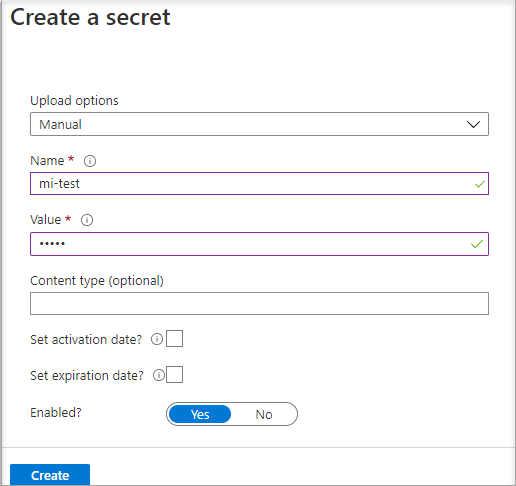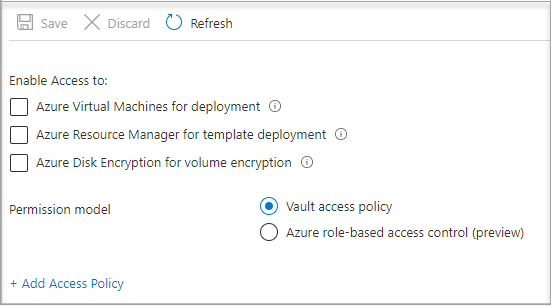Tutorial: Use a Linux VM system-assigned managed identity to access Azure Key Vault
Managed identities for Azure resources is a feature of Microsoft Entra ID. Each of the Azure services that support managed identities for Azure resources are subject to their own timeline. Make sure you review the availability status of managed identities for your resource and known issues before you begin.
This tutorial shows you how a Linux virtual machine (VM) can use a system-assigned managed identity to access Azure Key Vault. Key Vault makes it possible for your client application to then use a secret to access resources not secured by Microsoft Entra ID. Managed Service Identities are automatically managed by Azure and enable you to authenticate to services that support Microsoft Entra authentication, without including authentication information in your code.
You learn how to:
- Grant your VM access to a secret stored in a Key Vault
- Get an access token using the VM's identity and use it to retrieve the secret from the Key Vault
Prerequisites
- A basic understanding of Managed identities. If you're not familiar with the managed identities for Azure resources feature, see this overview.
- An Azure account, sign up for a free account.
- "Owner" permissions at the appropriate scope (your subscription or resource group) to perform required resource creation and role management steps. If you need assistance with role assignment, see Assign Azure roles to manage access to your Azure subscription resources.
- You also need a Linux Virtual machine that has system assigned managed identities enabled.
- If you need to create a virtual machine for this tutorial, you can follow the article titled Create a Linux virtual machine with the Azure portal
Create a Key Vault
Tip
Steps in this article might vary slightly based on the portal you start from.
This section shows how to grant your VM access to a secret stored in a Key Vault. Using managed identities for Azure resources, your code can get access tokens to authenticate to resources that support Microsoft Entra authentication. However, not all Azure services support Microsoft Entra authentication. To use managed identities for Azure resources with those services, store the service credentials in Azure Key Vault, and use the VM's managed identity to access Key Vault to retrieve the credentials.
First, we need to create a Key Vault and grant our VM's system-assigned managed identity access to the Key Vault.
Sign in to the Azure portal.
At the top of the left navigation bar, select Create a resource.
In the Search the Marketplace box type in Key Vault and hit Enter.
Select Key Vault from the results.
Select Create.
Provide a Name for the new key vault.

Fill out all required information making sure that you choose the subscription and resource group where you created the virtual machine that you are using for this tutorial.
Select Review+ create
Select Create
Create a secret
Next, add a secret to the Key Vault, so you can retrieve it later using code running in your VM. In this tutorial, we are using PowerShell but the same concepts apply to any code executing in this virtual machine.
Navigate to your newly created Key Vault.
Select Secrets, and select Add.
Select Generate/Import
In the Create a secret screen from Upload options leave Manual selected.
Enter a name and value for the secret. The value can be anything you want.
Leave the activation date and expiration date clear, and leave Enabled as Yes.
Select Create to create the secret.

Grant access
The managed identity used by the virtual machine needs access to read the secret stored in Key Vault.
Navigate to your newly created Key Vault
Select Access Policy from the menu on the left side.
Select Add Access Policy

In the Add access policy section under Configure from template (optional) choose Secret Management from the pull-down menu.
Choose Select Principal, and in the search field enter the name of the VM you created earlier. Select the VM in the result list and choose Select.
Select Add
Select Save.
Access data
To complete these steps, you need an SSH client. If you are using Windows, you can use the SSH client in the Windows Subsystem for Linux. If you need assistance configuring your SSH client's keys, see How to Use SSH keys with Windows on Azure, or How to create and use an SSH public and private key pair for Linux VMs in Azure.
Important
All Azure SDKs support the Azure.Identity library that makes it easy to acquire Microsoft Entra tokens to access target services. Learn more about Azure SDKs and leverage the Azure.Identity library.
In the portal, navigate to your Linux VM and in the Overview, select Connect.
Connect to the VM with the SSH client of your choice.
In the terminal window, use CURL to make a request to the local managed identities for Azure resources endpoint to get an access token for Azure Key Vault.
The CURL request for the access token is below.
curl 'http://169.254.169.254/metadata/identity/oauth2/token?api-version=2018-02-01&resource=https%3A%2F%2Fvault.azure.net' -H Metadata:trueThe response includes the access token you need to access Resource Manager.
Response:
{"access_token":"eyJ0eXAi...", "refresh_token":"", "expires_in":"3599", "expires_on":"1504130527", "not_before":"1504126627", "resource":"https://vault.azure.net", "token_type":"Bearer"}You can use this access token to authenticate to Azure Key Vault. The next CURL request shows how to read a secret from Key Vault using CURL and the Key Vault REST API. You need the URL of your Key Vault, which is in the Essentials section of the Overview page of the Key Vault. You also need the access token you obtained on the previous call.
curl 'https://<YOUR-KEY-VAULT-URL>/secrets/<secret-name>?api-version=2016-10-01' -H "Authorization: Bearer <ACCESS TOKEN>"The response looks like this:
{"value":"p@ssw0rd!","id":"https://mytestkeyvault.vault.azure.net/secrets/MyTestSecret/7c2204c6093c4d859bc5b9eff8f29050","attributes":{"enabled":true,"created":1505088747,"updated":1505088747,"recoveryLevel":"Purgeable"}}
Once you retrieved the secret from the Key Vault, you can use it to authenticate to a service that requires a name and password.
Clean up resources
When you want to clean up the resources, sign in to the Azure portal, select Resource groups, locate, and select the resource group that was created in the process of this tutorial (such as mi-test), and then use the Delete resource group command.
Alternatively you can also do this via PowerShell or the CLI.
Next steps
In this tutorial, you learned how to use a Linux VM system-assigned managed identity to access Azure Key Vault. To learn more about Azure Key Vault see:
Feedback
Coming soon: Throughout 2024 we will be phasing out GitHub Issues as the feedback mechanism for content and replacing it with a new feedback system. For more information see: https://aka.ms/ContentUserFeedback.
Submit and view feedback for